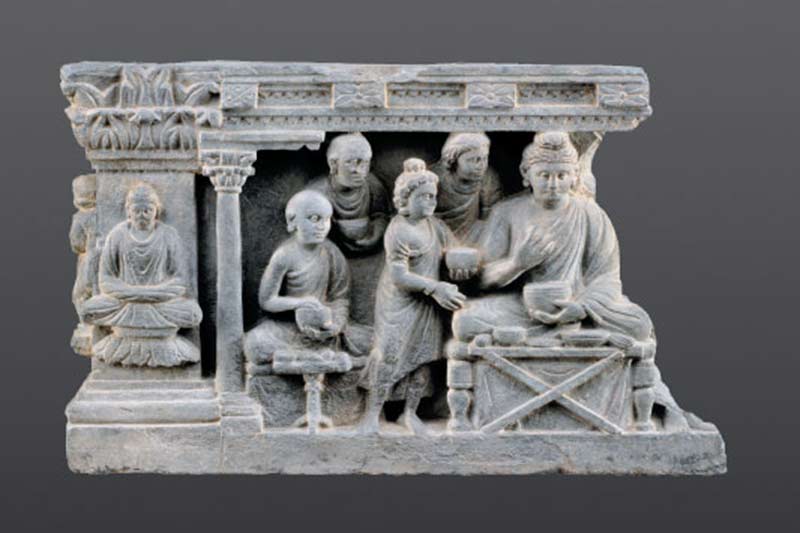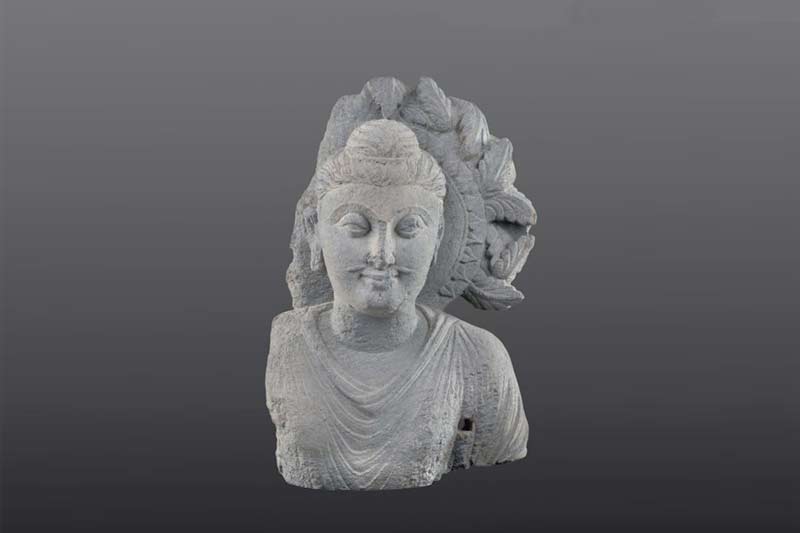The art of Gandhara
South East Asian Art Collection
When India met Greece
The two countries met some 2,300 years, in 326 BC, when Alexander the Great led his troops all the way through to Indus River. From 280 BC on, Greek kingdoms were created in northern Punjab by Bactrian Greeks while in 164-150 BC, King Eucratides, completed the occupation of Arachosia, Gedrosia, Gandhara, Taxila and Punjab, reaching as far as the Ganges Basin. Later on (100-80 BC), Menander took over the western valley of the Ganges
and Gudjrat and was tought the Buddhist faith. He founded the Greco-Indian Kingdom (capital city: Sagala) and used coins with bilingual inscriptions in Greek and Hindi script.
Ancient Gandhara
Ancient Gandhara was spread in an area that today includes eastern Afghanistan, part of Pakistan, western Punjab and parts of it in the north, as well as the whole ancient Kashmir.
Gandhara is known from the influence that the Greek civilization exerted in central Asia. This influence was a result of the stay of Alexander the Great and the Seleukids in the area in the 4th century as well as of the creation, in the 3rd and 2nd century B.C., of the Hellenistic kingdoms of Baktria in the north and of Hindus in the south. In this area from the 1st to the 6th century a peculiar style was created that is known as the “Greco-Buddhist art of Gandhara”.
The art of Gandhara
The art of Gandhara, and especially sculpture, is differentiated from the art of other areas of Central Asia, as it is mainly influenced from Hellenistic models.
This influence is clearly detected in the decoration of sculptures which includes a multitude of Hellenistic themes and patterns, such as winged atlases, putti with garlands and flowers, meanders, scrolls, Corinthian and Ionian capitals, vines and bunches of grapes, anthemions and acanthus leaves. Also Hellenistic influences can be detected in the draperies of the figures that remind of the Greek cloak.
Buddhist art was initially aniconic. The first depiction of Buddha with human form coincides with the conquest of Central Asia and part of northern India from Kushan. In the 2nd and 1st century B.C. Kushan, who originated from the north-west borders of China, marched southwards and gradually conquered the Hellenistic kingdoms of Baktria and Hindus, as well as the Indian-controlled area of Punjab.
From the 1st to the 5th century A.D.
From the 1st to the 5th century A.D. in the local workshops of Gandhara statues of Buddha and Boddhisattvas (the saints of Buddhism) were made. In these sculptures, the image of Buddha has strong Greek traits. Usually it is modeled on Apollo or Dionysus, with Greek nose and Greek hairstyle with undulated hair tied on the top of the head in a bun.
These characteristics are mixed with Asian traits, such as the protruding eyes and cheekbones.
From the 1st to the 7th century A.D. in Gandhara narrative reliefs on schist are made with themes from Buddhist iconography.
They depict scenes before and after the Buddha’s Enlightenment, his teaching, death and attainment of timeless Nirvana, as well as episodes from his previous lives. Usually they were decorating the stupas, the sacred burial mounds of Buddhism. These reliefs give the impression of a rigid arrangement, lack of depth, and a dullness of detail, despite of the occasionally vivid animation of the figures.
The radiance of all great Buddhist religious centres in the area, such as Swat, Peshawar and Taxila, kindled the spreading of Buddhism as far as Indochina (Cambodia, Thailand), the Himalayas (Nepal, Tibet) and the Far East (China, Korea and Japan).
BUDDHA HAVING DINNER WITH MONKS

BUDDHA


